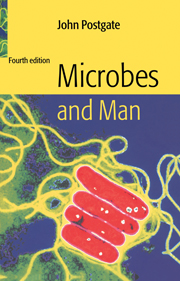Book contents
- Frontmatter
- Contents
- Illustrations
- Preface
- 1 Man and microbes
- 2 Microbiology
- 3 Microbes in society
- 4 Interlude: how to handle microbes
- 5 Microbes in nutrition
- 6 Microbes in production
- 7 Deterioration, decay and pollution
- 8 Disposal and cleaning-up
- 9 Second interlude: microbiologists and man
- 10 Microbes in evolution
- 11 Microbes in the future
- Further reading
- Glossary
- Index
8 - Disposal and cleaning-up
Published online by Cambridge University Press: 18 December 2009
- Frontmatter
- Contents
- Illustrations
- Preface
- 1 Man and microbes
- 2 Microbiology
- 3 Microbes in society
- 4 Interlude: how to handle microbes
- 5 Microbes in nutrition
- 6 Microbes in production
- 7 Deterioration, decay and pollution
- 8 Disposal and cleaning-up
- 9 Second interlude: microbiologists and man
- 10 Microbes in evolution
- 11 Microbes in the future
- Further reading
- Glossary
- Index
Summary
In the last chapter I looked at the destructive effects that microbes can have on materials. I noted at the start, however, that these destructive effects represent an important function that microbes perform in the natural economy of this planet: they remove the detritus generated by higher plants and animals so as to recirculate the biologically important elements contained in it. Deterioration, corrosion and pollution, when brought about by microbes, are simply special cases of this general function, and so are disposal and cleaningup processes, in which microbes are deliberately used to get rid of unwanted matter and pollutants.
The most important example of a microbiological disposal process is sewage treatment and, since it is fundamental to the health of all civilized societies, as well as being intellectually a most satisfying form of applied microbiology, I shall spend a little time discussing it.
When the population of the world was small, sewage disposal presented few problems. The Greeks and Romans had hygienic systems, often building their baths and lavatories over or near running water. The Romans, in particular, built their baths and sewerage systems to last, and there is a pleasing irony in the fact that these sewerage systems are often all that remain in excavated Roman communities. Standards then fell, and descriptions of life in the Middle Ages and during the Renaissance tell us that human habitations must sometimes have resembled pigsties: steps and odd corners were used as lavatories, refuse was thrown into streets, chamber pots were emptied into the streets and people rarely bathed.
- Type
- Chapter
- Information
- Microbes and Man , pp. 270 - 290Publisher: Cambridge University PressPrint publication year: 2000



